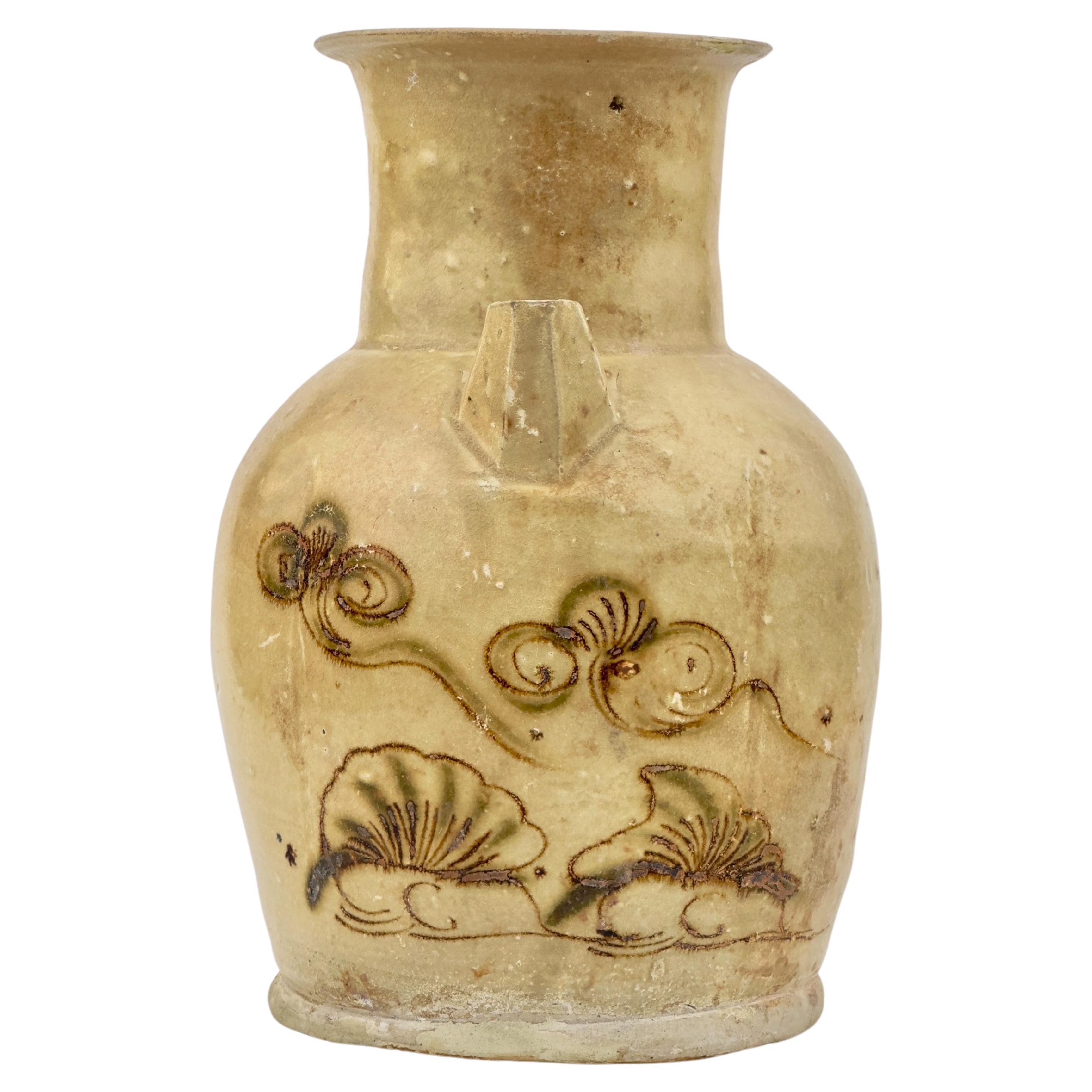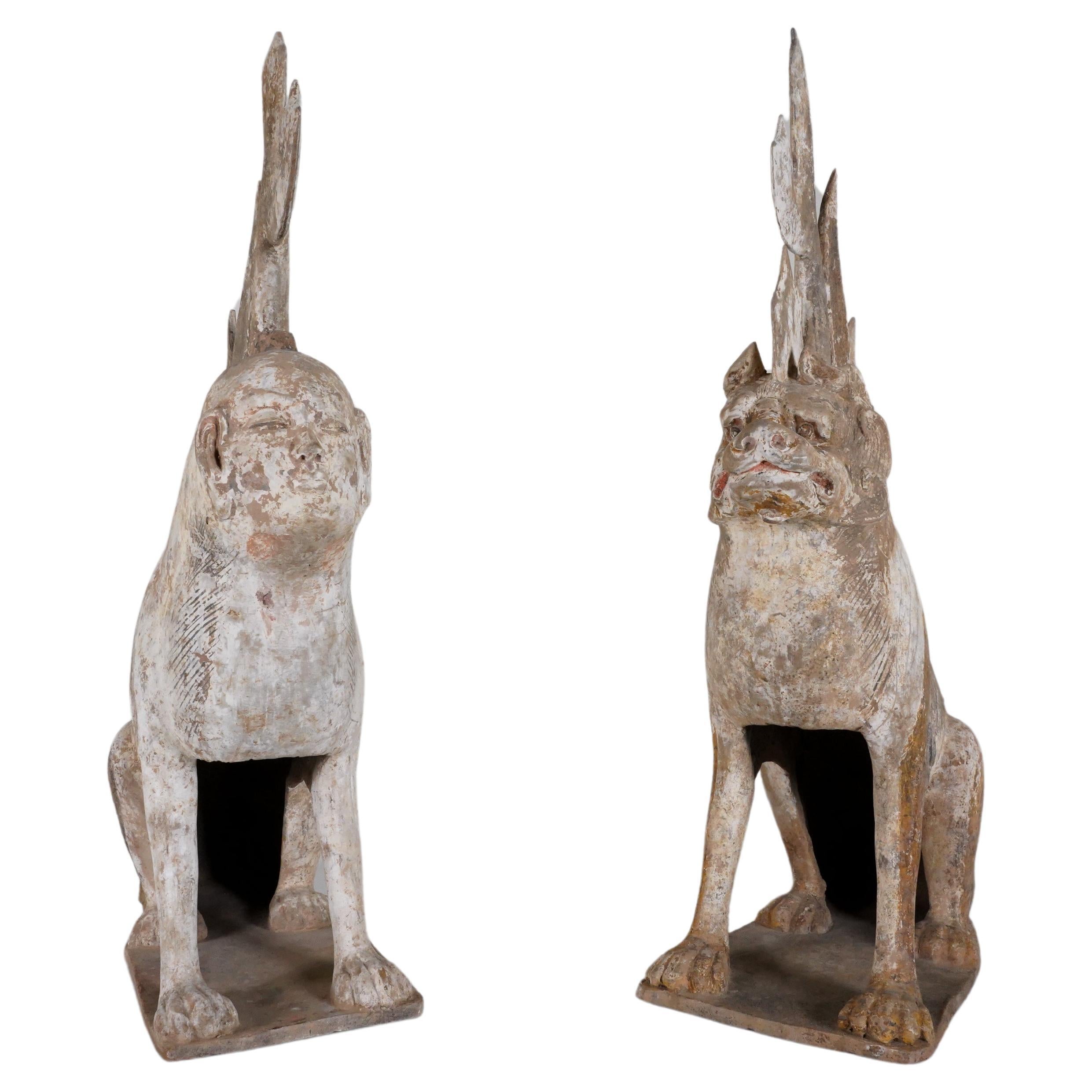Items Similar to Changsha ewer, Tang Dynasty(618-907)
Want more images or videos?
Request additional images or videos from the seller
1 of 10
Changsha ewer, Tang Dynasty(618-907)
About the Item
Changsha Ware has distinct and recognizable designs and motifs. Painted designs often depict flowers, vines, clouds and mountain landscapes. Some painting is simply splotches of color that accentuate stamped and molded clay ornaments. You can see the expressions of people of the time through abstract depictions of Changsha ware
Date : 9th Century
Type : Changsha
Made in : Hunan province
Provenance : Acquired in late 1990s from Hongkong
Reference :
1) Sotheby's New York 17 March 2015 - Song Tradition: Early Ceramics From The Yang De Tang Collection - Lot 52
(Price realised : 12,500 USD / Type : Closely related)
* Changsha Ware
Multiple “wares,” or styles, of pottery were developed during the Tang Dynasty. Many of these wares featured sancai glazing, a distinct color palette of lead glazes brushed, dipped, and poured over the vessel. Sancai glazed pottery used three colors derived from minerals: yellow-brown from iron oxide, green from copper oxide, and white from lead. Rarely, ceramicists included cobalt to create a blue glaze, but it was far too expensive for regular use. Changsha Ware is a classic example of a three-color sancai ware. Yet, it is also a style that revitalized ancient Chinese pottery. It was the first time that ceramicists perfected the underglaze painting technique. Artists decorated their clay bowls, jars, and figurines with colorful paintings and delicate calligraphy which were then protected by a transparent coat of lead glaze.
Changsha Ware was produced with distinct and recognizable designs and motifs. Painted designs often depict flowers, vines, and mountain landscapes. Some painting is simply splotches of color that accentuate stamped and molded clay ornaments. Being sold overseas, Changsha Ware integrated foreign cultural elements with traditional Chinese aesthetic principles.
Changsha Ware varies widely in form. To make sense of this variability, objects are typically classified into functional categories such as bowls, pots, ewers (or jugs), plates, boxes, lamps, pillows, candlesticks, censers, water droppers, mortars, paper weights, tea grinders, and figurines. Examples of these forms can be found below.
References : Timothy S.Y. Lam Museum of Anthropology
About the Seller
New to 1stDibs
Joined in the past six months.
4.5
Vetted Seller
These experienced sellers undergo a comprehensive evaluation by our team of in-house experts.
Established in 1999
1stDibs seller since 2023
Typical response time: 1 hour
- ShippingRetrieving quote...Ships From: seoul, Korea South
- Return PolicyA return for this item may be initiated within 10 days of delivery.
More From This SellerView All
- Changsha ewer, Tang Dynasty(618-907)Located in seoul, KRChangsha Ware has distinct and recognizable designs and motifs. Painted designs often depict flowers, vines, clouds and mountain landscapes. Some painting is simply splotches of colo...Category
Antique 15th Century and Earlier Chinese Tang Antiquities
MaterialsStoneware
- Changsha Ewer, Tang DynastyLocated in seoul, KRIt features two small lug handles on either side of the neck and a spout opposite the main handle. This ewer might have been used for wine or other liquids, which were poured through...Category
Antique 15th Century and Earlier Chinese Tang Antiquities
MaterialsPottery, Stoneware
- Rare Lion Figurine Pillow, Tang Dynasty(618-907)Located in seoul, KRTo meet overseas demand, shapes of Changsha wares were also greatly influenced by exotic elements from beyond China. For example, lion-shaped artifacts were found, as were a number o...Category
Antique 15th Century and Earlier Chinese Tang Antiquities
MaterialsStoneware
- Changsha bowl with abstract pattern presumed to be Islamic symbols, Tang DynastyLocated in seoul, KRThe edges have been dipped in four places with brown, probably iron-oxide. The well of the bowl is freely painted in green and coffee coloured brown. Period : Late Tang Dynasty Prod...Category
Antique 15th Century and Earlier Chinese Tang Antiquities
MaterialsStoneware
- Belitung ship, Large Changsha bowl with plant patterns, Tang PeriodLocated in seoul, KRThe edges have been dipped in four places with brown, probably iron-oxide. The well of the bowl is freely painted in green and coffee coloured brown. Period : Late Tang Dynasty Prod...Category
Antique 15th Century and Earlier Chinese Tang Antiquities
MaterialsPottery
- A Sancai-glazed pottery 'Haitai' Pillow, Tang dynastyLocated in seoul, KRThe pillow is intricately decorated with a vibrant pattern, demonstrating the craftsmanship and artistic sensibilities of the period. The Haitai is a creature from Chinese mythology,...Category
Antique 15th Century and Earlier Chinese Tang Antiquities
MaterialsEarthenware, Pottery
You May Also Like
- Chimera (Pixiu) Terracotta Mythological Being - Tang Dynasty, China '618-907 AD'Located in San Pedro Garza Garcia, Nuevo LeonMagnificent Mythological Being "Chimera" with Human Face and Flaming Rays Halo. Orange Terracotta with Traces of Stucco and Painting. This creature is commonly known as Pixiu. Fierc...Category
Antique 15th Century and Earlier Chinese Tang Antiquities
MaterialsTerracotta
- A Pair of Tang Dynasty (618-907 CE) Pottery Earth Spirit FiguresLocated in Chicago, ILA beautiful and rare pair of "Earth Spirit" guardians from the Shaanxi province region along the Yellow River valley of northern China. These figures were created from clay earthenwa...Category
Antique 15th Century and Earlier Chinese Tang Antiquities
MaterialsTerracotta
- Pair Tang Dynasty Dancing Figures, China '618-907AD'Located in Dallas, TXPeriod: Tang Dynasty (618 – 907 AD) terra-cotta over lead clay A pair of delicate Tang Dynasty dancers with long sleeves. Both ladies are wearing a long flowing dress with flared ...Category
Antique 15th Century and Earlier Chinese Antiquities
MaterialsTerracotta
- Very Elegant Tang Dynasty Dignitary in Orange Terracotta, China '618-907 AD'Located in San Pedro Garza Garcia, Nuevo LeonVery elegant terracotta dignitary in blue and red robes standing with the hands joined at the chest. He wears a blue headdress with a bird at its center. Orange Terracotta This gorg...Category
Antique 15th Century and Earlier Chinese Tang Antiquities
MaterialsTerracotta
- China 618-907 AD Tang Dynasty Pair Of Polychromate Earth Spirits ZhenmushouLocated in Miami, FLPair of Earths Spirits "Zhenmushou" from the China Tang Dynasty 618-907 AD. A beautiful and rare pair of "Earths Spirits guardians" from the Yunnan province region in the ancient China. This was created in clay earthenware pottery during the Tang Dynasty period between 618 and 907 AD. Featuring the molded figures of two seated guardians with decorations with polychrome pigmentations. The figures are seated on their haunches with cloven hooves planted firmly on the base looking forward with their front legs in a straight position. Both with face and body alert expressions on a rectangular base. Earth spirits usually appear in pairs, one with a human head and the other with a lion head. Their supernatural powers, indicated by antlers, spiky flanges and flames, enable them to confront evil spirits and protect any precincts within their gaze. Have been believed to protect the living by keeping the spirits of the dead from inappropriately roaming the world outside the tomb. Zhenmushou or guardian deities, developed from a line of protective spirits found normally in pairs at the front of Tang dynasty tombs. They served both to protect the figure from untoward spirits, and the outside world from the roving spirit of the dead. Combining features from a number of animals to form the perfect mythic beast, these mythical creatures were perceived to be the ideal guardians of the dead The semi human faced figure has a measures of 11.25 by 4.5 by 5.75 inches (28.57 x 11.43 x 14.60 Cm). The mythological lion animal figure has a measures of 10 by 5 by 5.8 inches (24.5 x 12.7 x 14.73 Cm). Tang dynasty or Tang Empire, was an imperial dynasty of China that ruled from 618 to 907, with an interregnum between 690 and 705. It was preceded by the Sui dynasty and followed by the Five Dynasties and Tend Kingdoms period. Historians generally regard the Tang as a high point in Chinese civilization, and a the golden age of cosmopolitan culture. Tang territory, acquired through the military campaigns of its early rulers, rivaled that of the Han dynasty. The Li family founded the dynasty, seizing power during the decline and collapse of the Sui Empire and inaugurating a period of progress and stability in the first half of the dynasty's rule. The dynasty was formally interrupted during 690–705 when Empress Wu Zetian seized the throne, proclaiming the Wu Zhou dynasty...Category
Antique 15th Century and Earlier Chinese Tang Antiquities
MaterialsEarthenware, Pottery
- China 618-907 Ad Tang Dynasty Ancient Earthenware Sculpture of a Walking HorseLocated in Miami, FLStanding horse from the Tang Dynasty 618-907 AD. Beautiful sculptural piece of art from the Chinese ancient period of the Tang Dynasty (618-907 AD) featuring the finely sculptural figure of a horse, carefully made of earthenware clay pottery. The horse is standing in a very elegant and majestic position striding the four legs crossed. The animal has a slightly arched neck to the left looking forward and its extremely well modeled. The body is embellished with a beautiful saddle and intricate harnesses. The surface is treated with applications of natural color pigments such; white, light red and grays. Has a measurements of 343 mm by 140 mm by 356 mm (13.5 x 5.5 x14 Inches) (34.3 x 14 x 35.6 Cm). Tang dynasty or Tang Empire, was an imperial dynasty of China that ruled from 618 to 907, with an interregnum between 690 and 705. It was preceded by the Sui dynasty and followed by the Five Dynasties and Tend Kingdoms period. Historians generally regard the Tang as a high point in Chinese civilization, and a the golden age of cosmopolitan culture. Tang territory, acquired through the military campaigns of its early rulers, rivaled that of the Han dynasty. The Li family founded the dynasty, seizing power during the decline and collapse of the Sui Empire and inaugurating a period of progress and stability in the first half of the dynasty's rule. The dynasty was formally interrupted during 690–705 when Empress Wu Zetian seized the throne, proclaiming the Wu Zhou dynasty...Category
Antique 15th Century and Earlier Chinese Tang Antiquities
MaterialsEarthenware, Pottery
Recently Viewed
View AllMore Ways To Browse
Chinese Tea Pots Blue White
Blue And White Censer
Antique Chinese Water Jug
Chinese Water Jug
Blue And White Candlestick Lamps
Chinese Dynasty Boxes
Chinese Pot Lamp
Iron Mountain Stoneware
Sancai Lamp
Chinese Blue And White Brush Pots
Dynasty Box
Blue And White Tea Pots
Chinese Blue And White Tea Bowls
Chinese Water Dropper
Asian Water Jug
Chinese Blue And White Tea Jar
Antique Dao
Chinese Jade Carved Screens And Stand





